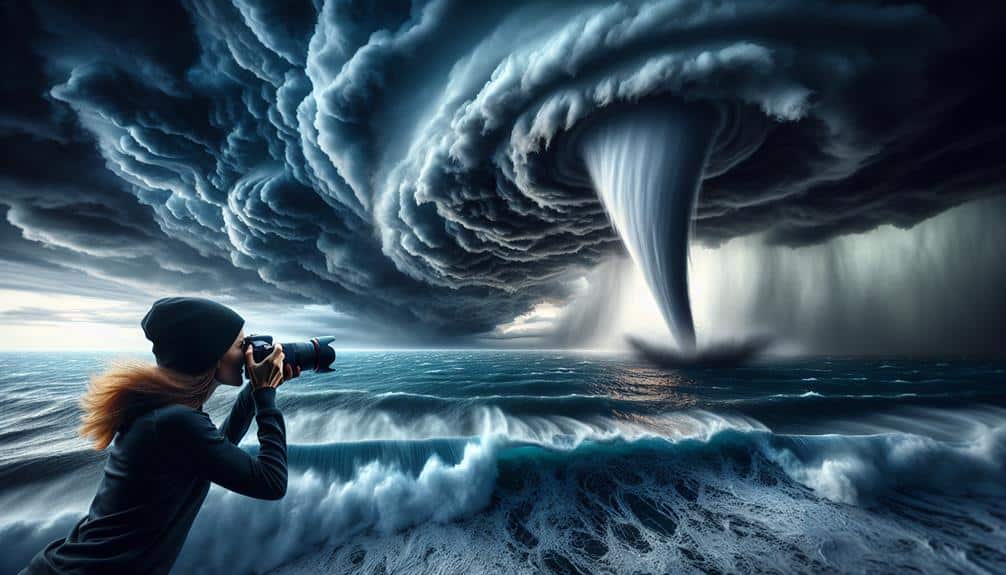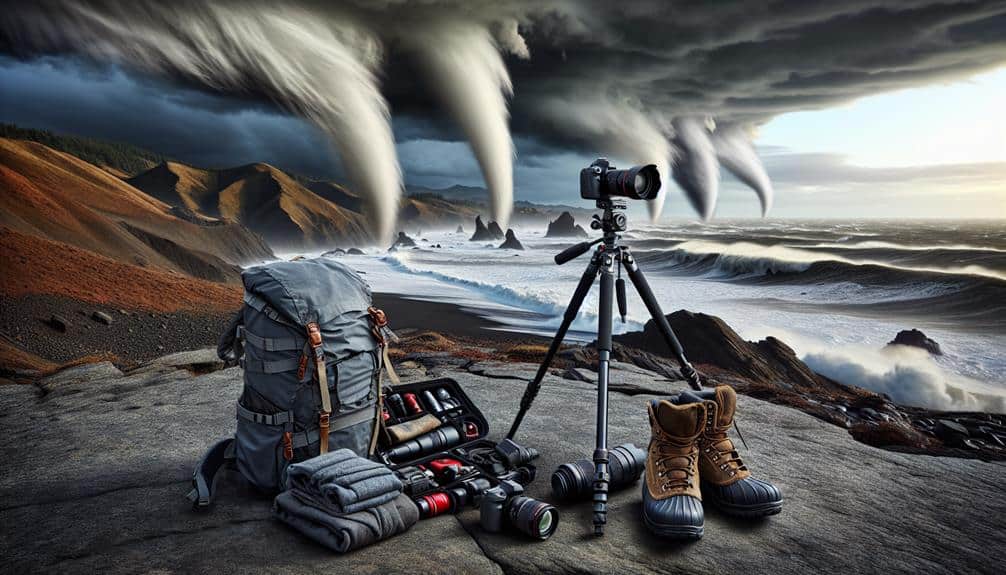Capturing jaw-dropping waterspout footage requires a seamless blend of meteorological expertise and top-tier equipment. We prioritize weatherproof cameras with high frame rates and robust stabilization. Mastering weather prediction and identifying cumulus clouds is critical for positioning ourselves perfectly. Wide-angle lenses provide broad perspectives, while a telephoto lens offers intricate details. Safety is paramount; we adhere to strict protocols, employ GPS for navigation, and stay prepared with emergency gear. Achieving stunning shots involves meticulous composition, adjusting exposure for peak moments, and shooting during golden hours. For those looking to elevate their footage to cinematic quality, there's more to uncover.
Key Points
- Use weatherproof cameras with high frame rates and advanced stabilization for clear, smooth footage.
- Position yourself safely and leverage contrasting backdrops to highlight waterspouts' swirling motion.
- Master weather prediction and GPS navigation to identify and reach waterspout hotspots efficiently.
- Adjust camera settings for optimal exposure, sharpness, and depth of field, especially during golden hours.
Choosing the Right Equipment
When selecting equipment for waterspout chasing, it's important to prioritize durable weatherproof cameras with high frame rates and advanced stabilization features. We need cameras that can endure harsh conditions and still deliver high-quality footage. Our primary focus should be on models with high frame rates, preferably 60 fps or higher, to capture the rapid movements of waterspouts with clarity. Additionally, optical image stabilization is non-negotiable to guarantee smooth footage even in turbulent environments.
Lens choice is equally important. Wide-angle lenses allow us to encompass the entire scene, providing a broader perspective of the waterspout's formation and movement. However, having a telephoto lens on hand can be advantageous for capturing intricate details from a safer distance.
Deciding between tripod-mounted and handheld filming is another essential consideration. Tripods provide stability and allow us to capture steady, professional-grade footage. However, the agility of handheld filming can't be underestimated, especially when quick repositioning is necessary.
We recommend a hybrid approach: use a sturdy, weather-resistant tripod for initial setup and switch to handheld when mobility becomes necessary.
Understanding Waterspout Formation
Understanding the mechanics behind waterspout formation requires a thorough exploration into meteorological principles and atmospheric dynamics. Waterspouts, basically tornadoes over water, form under specific weather patterns involving instabilities within the lower atmosphere. They typically occur in regions where warm, moist air rises and interacts with cooler air above. This temperature gradient, combined with rotational wind shear, creates the spinning column of air and water we aim to capture.
Meteorological conditions conducive to waterspout formation often include cumulus cloud development in coastal areas. Recognizing these telltale signs is important for us to anticipate and prepare for the chase. Scientific explanations reveal that there are two primary types of waterspouts: fair-weather and tornadic. Fair-weather waterspouts form along the base of cumulus clouds, while tornadic waterspouts are associated with severe thunderstorms.
For capturing jaw-dropping footage, understanding these dynamics is essential. Photography tips emphasize positioning ourselves at a safe distance with the sun behind us to illuminate the waterspout. The best angles often come from a side perspective, allowing us to capture the full structure against a contrasting backdrop of sky and sea. By mastering these elements, we can enhance both the safety and quality of our footage.
Planning Your Chase Route
Armed with knowledge about waterspout formation and best filming techniques, we now focus on carefully planning our chase route to maximize the likelihood of capturing stunning footage. The first step is mastering weather prediction. We rely on real-time meteorological data, including satellite imagery, radar readings, and weather models, to identify potential waterspout hotspots. Understanding atmospheric conditions like wind shear, humidity, and temperature gradients is essential.
Our navigation strategy is equally important. We use GPS technology and topographic maps to plot the most efficient routes to these identified hotspots. Coastal areas with a history of waterspout activity become our primary targets. We also need to take into account accessibility—choosing locations that allow us to quickly reposition for ideal filming angles while ensuring we stay ahead of the waterspout's path.
Timing is everything. We synchronize our movements with the predicted development times of waterspouts, often early morning or late afternoon, when atmospheric conditions are most favorable. By combining precise weather prediction with a well-thought-out navigation strategy, we enhance our chances of being in the right place at the right time, ready to capture that perfect shot.
This careful planning sets the stage for our next important consideration: safety precautions for chasers.
Safety Precautions for Chasers
Prioritizing our safety during waterspout pursuits is paramount, necessitating strict adherence to protocols and constant vigilance. Before we even set out, thorough risk assessment is vital. We need to evaluate weather patterns, potential escape routes, and the proximity of emergency services. This assessment informs our emergency preparedness, guaranteeing we're ready for any sudden changes in conditions.
Equipping ourselves with the proper protective gear is non-negotiable. Waterproof clothing, durable footwear, and life vests are crucial for our safety. Additionally, eye protection against wind-driven debris and a well-stocked first aid kit can mitigate many hazards we might face. Each of these items should be considered essential for the pursuit.
Communication planning is another critical component. Maintaining constant contact with each other and with a reliable base station ensures we can relay our position and status. Two-way radios, satellite phones, and GPS devices are indispensable tools in our arsenal. They provide a lifeline if cellular networks fail, enabling us to navigate back to safety or call for help if necessary.
Techniques for Stunning Shots

To capture truly breathtaking waterspout footage, we need to fine-tune our camera settings for best exposure and sharpness. Timing our shots to coincide with peak activity and dramatic lighting enhances the visual impact.
Additionally, framing dynamic scenes by incorporating foreground elements and leading lines creates a sense of scale and movement.
Optimal Camera Settings
Mastering the art of capturing stunning waterspout footage requires meticulous attention to camera settings. This includes aperture, shutter speed, and ISO sensitivity.
First, let's tackle exposure control. Balancing exposure is essential; too much light washes out the details, while too little leaves the scene in shadows. Adjust the aperture settings to around f/8 to f/11 to achieve a depth of field that keeps the waterspout and surrounding environment in sharp focus.
Shutter speed is another vital factor. We recommend setting it between 1/500 and 1/1000 of a second. This range freezes the rapid movement of the waterspout, preventing motion blur while capturing the intricate details of its formation.
For white balance, use the 'cloudy' setting to enhance the contrast and color accuracy of the turbulent skies and the waterspout itself.
ISO sensitivity should generally be kept low, around 100 to 400, to minimize noise and graininess in your footage. Higher ISO settings may introduce unwanted artifacts, diminishing the clarity of your shots.
Perfect Timing Tips
Timing is everything when capturing stunning waterspout footage, and we need to anticipate the exact moment the waterspout forms to frame the most dramatic shots. To achieve this, precise weather monitoring is vital. We rely on real-time data from Doppler radar and satellite imagery to identify ideal locations where waterspouts are likely to develop.
Once we've pinpointed a potential hotspot, lighting conditions become our next focus. The golden hours of early morning or late afternoon offer softer, more dynamic lighting, which adds depth and drama to our footage. However, overcast skies with diffused light can also create striking contrasts, highlighting the waterspout against a moody backdrop.
Composition tips are essential for elevating the visual impact of our shots. We must make sure the horizon line is level, using the rule of thirds to position the waterspout off-center, creating a more engaging scene. Additionally, capturing the interaction between the waterspout and its surroundings—like turbulent waves or distant landmarks—enhances the narrative and draws viewers into the moment.
Framing Dynamic Scenes
Framing dynamic scenes requires a keen eye for detail and an intuitive understanding of spatial relationships to capture the raw power and beauty of waterspouts in their full glory.
We need to assess composition angles meticulously; the angle at which we shoot can dramatically alter the perception of the waterspout's scale and intensity. By positioning ourselves low to the ground and angling upward, we can emphasize the towering nature of these natural phenomena, invoking a sense of awe and grandeur.
Lighting plays a vital role in these shots. We should aim to shoot during golden hours—early morning or late afternoon—when the sunlight casts a warm, diffused glow, enhancing the visual texture of the waterspout and the surrounding environment.
For action shots, capturing the swirling motion of the waterspout against a dark, stormy backdrop can highlight the contrast and drama.
Close-ups are equally essential. Zooming in on the base of the waterspout where it meets the water can reveal intricate details and dynamic interactions between air and water. By balancing wide shots and close-ups, we create a detailed visual narrative that showcases the waterspout's majesty and power in stunning detail.
Editing and Sharing Your Footage
Once you've captured your stunning waterspout footage, the next important step involves using advanced video editing software to enhance the visual impact and make sure a seamless narrative flow before sharing it with your audience. Let's jump into creating montages and editing our footage to elevate the viewer's experience.
Using tools like Adobe Premiere Pro or Final Cut Pro, we can craft compelling montages that highlight the most intense moments. It's vital to trim excess footage and synchronize cuts to the rhythm of evocative background music. Color grading also plays a crucial role in bringing out the vivid hues of the sky and water, adding depth and emotion to each frame.
When it comes to social media sharing, selecting the right platforms is essential for maximizing reach and engagement.
- YouTube: Ideal for full-length, high-definition videos.
- Instagram: Perfect for short, visually engaging clips.
- Twitter: Effective for quick updates and teaser trailers.
- Facebook: Great for community building and longer posts.
Once our video is polished, we should tailor the format and length to each platform's unique audience. By doing so, we guarantee our jaw-dropping waterspout footage reaches and resonates with as many viewers as possible.
Frequently Asked Questions
How Can I Predict the Best Time of Year for Waterspout Activity?
We can predict the peak season for waterspout activity by analyzing historical data and current meteorological conditions. Typically, late summer and early fall provide ideal, unstable atmospheric conditions necessary for waterspout formation over warm coastal waters.
What Are Some Common Misconceptions About Waterspouts?
Let's clear the fog: Waterspout formation isn't exclusive to oceans—they form over lakes too. People often think they're harmless but taking safety precautions seriously is crucial. Misjudging their power can lead to dangerous encounters.
Are There Any Regulations or Permits Required for Chasing Waterspouts?
To chase waterspouts, we don't need special permits, but we must adhere to safety regulations. Accurate forecasting, thorough preparation, and appropriate gear are essential. Prioritizing safety guarantees we can enjoy the freedom of this thrilling pursuit.
How Do Waterspouts Differ From Tornadoes on Land?
Waterspouts are the ocean's wild tornadoes, forming in unique weather patterns. Unlike land tornadoes, their formation involves warm water surfaces. These differences in characteristics create mesmerizing, yet dangerous phenomena that captivate our adventurous spirits.
What Insurance Considerations Should I Be Aware of When Chasing Waterspouts?
When chasing waterspouts, we should review our coverage options and premium rates closely. Ensuring robust liability protection and understanding damage claims are critical to avoid financial pitfalls. Reliable insurance safeguards our freedom to explore without undue risk.


